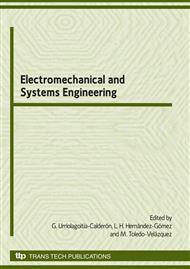[1]
J. Zarka and J. Casier, Elastic-plastic response of the structure to cyclic loading; practical rules, Mechanics Today, vol. 6, NematNasser, Pergamon Press, (1979).
DOI: 10.1016/b978-0-08-024749-6.50014-4
Google Scholar
[2]
F. Burgahn, O. Vöhringer and E. Macherauch, Microstructural investigation of the shot peened steel 42CrMo4 in different heat treatment conditions by the aid of a X-Ray profile analysis, Proc Int Shot Peening 4, Tokyo 1990, The Japan Society of Precision Engineering, (1990).
Google Scholar
[3]
E. Zaldivar-González, Efecto del tamaño de bola en el proceso de granallado, M Sc Thesis, SEPI ESIME Zacatenco, National Polytechnic Institute (2008).
Google Scholar
[4]
H. O. Fuchs, Techniques of surface stressing to avoid fatigue, Metal Fatigue, Mc Graw Hill, (1959), pp.197-229.
Google Scholar
[5]
J. Campaign, Controlled shot peening, Electronics Inc, (1986), pp.1-15.
Google Scholar
[6]
ASM International, Surface Engineering, vol. 5, USA: ASM Handbook, (1991).
Google Scholar
[7]
G. Urriolagoitia-Sosa, Analysis of prior strain history effect on mechanical properties and residual stresses in beams, Ph D Thesis, Oxford Brookes University (2005), pp.130-142.
Google Scholar
[8]
M. B. Prime, Residual stress measurement by successive extension of a slot: The crack compliance method, Applied mechanics reviews, Eng Sciences and Applications Divisions, MS P946, Los Alamos National Laboratory, NM, 87545, vol. 52, no. 2, (1999).
DOI: 10.1115/1.3098926
Google Scholar
[9]
W. Cheng and I. Finnie, An overview of the crack compliance method for residual stress measurement, Proc 4th Int Conf Residual Stress, Baltimore, Maryland, Society for Experimental Mechanics, (1994), pp.449-458.
Google Scholar
[10]
E. M. Beaney and E. Procter, A critical evaluation of the centre hole technique for the measurement of residual stresses, Strain, January, (1974), pp.7-14.
DOI: 10.1111/j.1475-1305.1974.tb00074.x
Google Scholar
[11]
N. Wadsley, Residual stress analysis, M Sc Thesis, Oxford Brookes University, (1994), p.12.
Google Scholar
[12]
P. C. T. Chen, A new method of predicting residual stresses in autofrettaged gun barrels, Journal of Pressure Vessels Technology, vol. 108, February, (1986), pp.108-112.
Google Scholar
[13]
X. R. Wu and A. J. Carlson, Weight function and stress intensity factor solutions, Pergamon Press, Oxford, England, (1991).
Google Scholar
[14]
G. Urriolagoitia-Sosa, J. F. Durodola, and N. A. Fellows, Determination of residual stress in beams under Bauschinger effect using surface strain measurements, Strain, vol. 39, no. 4, (2003), pp.177-185.
DOI: 10.1046/j.1475-1305.2003.00085.x
Google Scholar
[15]
W. Cheng, I. Finnie, and Ö. Vardar, "Measurement of residual stresses near the surface using the crack compliance method, Journal of engineering materials and technology, vol. 113, (1991), pp.199-204.
DOI: 10.1115/1.2903392
Google Scholar
[16]
G. Urriolagoitia-Sosa, J. F. Durodola and N. A. Fellows, Effect of strain hardening on residual stress distribution in beams determined using the crack compliance method, Journal of Strain Analysis for Engineering Design, vol. 42, no. 2, (2007).
DOI: 10.1243/03093247jsa165
Google Scholar
[17]
N. Dowling, Mechanical behavior of materials, Englewood Cliffs, Nj, Prentice Hall, (1993).
Google Scholar
[18]
SAE Manual on shot peening, (2001).
Google Scholar
[19]
A/SYS Manual 10. 0, (2007).
Google Scholar


